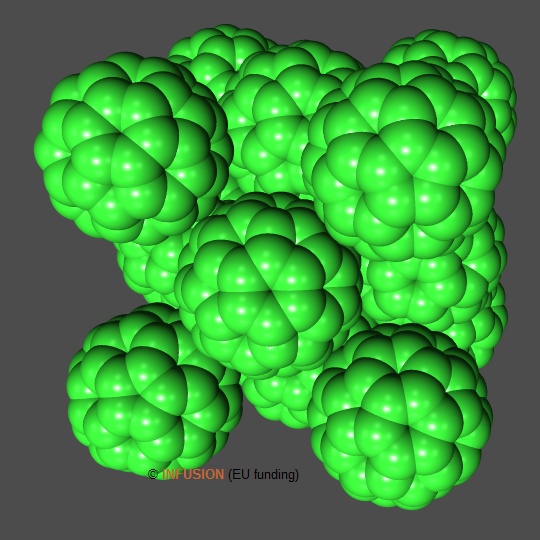Fullerites
Molecular crystals form one class of self-assembled structures. An example is the fullerites that denote crystalline form of fullerenes, such as C60 and C70. The ordering of the fullerenes is realized through Van der Waals interactions between them. In C60-fullerite, the molecules adopt a close-packed structure, very much like silica spherulites do in precious opal. At room temperature and normal pressure, C60-fullerite is a face-centered-cubic (FCC) crystal with lattice parameter 1.416 nm. In this crystal, the four molecules per cubic cell are equivalent due to their rotational motion at frequency around 1011 Hz. At low temperature, by contrast, the spinning of the C60 molecules is frozen. The FCC cell now contains four C60 with different but fixed orientations, the structure is simple cubic. The cohesive energy of the crystal is 1.6 eV/ C60.
 |
Representation of a FCC cell of C60-fullerite. The carbon atoms are represented by spheres with radius equal to their Van der Waals radius, 0.15 nm. Each C60 molecule has been drawn with an orientation chosen at random, like in a snapshot of the room-temperature phase. C60-fullerite can be intercalated with various elements, in particular alkali atoms. The intercalated atoms reside in the holes between the C cages and form fullerene compounds named fullerides. Although C60-fullerite is a semiconductor with band gap around 1.7 eV at room temperature, some fullerides derived from it may be conductors and even superconductors at low temperature. The Rb2CsC60 fulleride has a superconducting temperature as high as 32.5 K. |
At room temperature, C70-fullerite has the symmetry elements of the hexagonal close packed crystal with lattice parameters a = 1.06 nm and c = 1.74 nm. The cohesive energy of this Van der Waals crystal is 1.3 eV/C70. At 276 K, there is an orientational ordering transition, leading eventually to a monoclinic structure upon cooling.
Under pressure, the fullerites undergo several transformations, including polymerization of the cages and, ultimately, a collapse of the clusters leading to dense amorphous carbon.